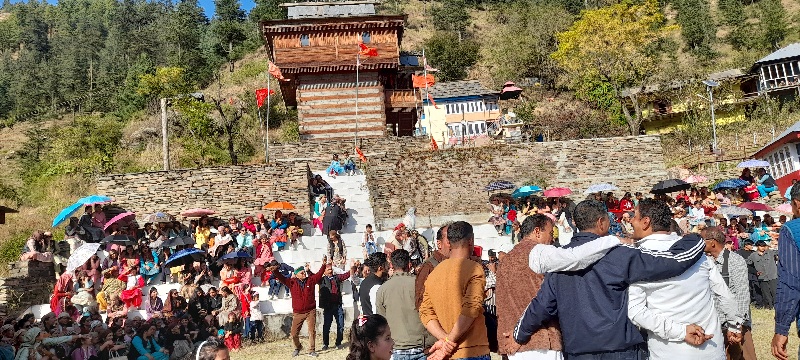Frenzied Devotees Collide at Khila Baraach: Badhan Rajputs and Bhat Brahmins Battle for the Sacred Khila at Bateuri, venue of the traditional contest.
SHANTHA/BATEURI: In unique Diwali festivities as the hills themselves, the villages of Shantha and Bateuri erupted into celebration, song, and a good-natured battle for the sacred Khila.
The four-day Diwali festival in the Shantha and Bateuri Bahal in Chopal region concluded with the Khila Baraach—a traditional collision between the Badhan Rajputs of Shantha and the Bhat Brahmins of Bateuri Bahal.
Both sides competed for the Khila, a one-foot sacred stick cut from the Bhekhal bush, measuring four grips of a man’s hand.
As the procession started off from Bateuri village, spirits were high, and thousands of devotees, young and old, filled the temple grounds and hillsides, their war cries echoing through the valley.
Devotees had carried the Palki of Devta Kulla Maharaj from the temple at Bateuri on their shoulders, dancing and singing in a scene alive with color, rhythm, and divine energy.
Accompanied by the beats of drums and the chanting of slogans the devalus and kardas led the way, making their pilgrimage to the hilltop spot known as Khila Badhaaj.
When they arrived, the sacred Khila, carved from the Bhekhal bush, was driven into the ground.
The Badhan Rajputs approached from the west bare feet and in shots, while the Bhat Brahmins stand at the east, both shouting slogans in praise of Dev Shirgul, invoking his legendary battles and protection over the entire human race.
The anticipation was electric—two sides of the same faith meeting not as adversaries but as spirited rivals, each side determined to claim the Khila.
The air thickened as the two groups converged. With fierce devotion, men, young boys, and seasoned elders lunged toward the Khila, pushing through thorny bushes and uneven terrain, undeterred by any injury or bruises.
The hillside erupted in a frenzy, with bodies rolling and hands reaching to grasp the sacred staff.
Onlookers cheered, caught in the energy of the battle as the hillside shook with the jostling of devotees.
Finally, amid the clash of bodies and chants, a young boy from the Badhan side managed to wrest the Khila free.
With a triumphant shout, Young Dishu, grandson of Late Dulla Ram Pahalwan was lucky as the group rolled down the slope and he had his way, snatched it and tossed it into air, securing victory for Badhans and seeking the Devata’s blessings.
The Brahmins and Badhans alike roared their approval, voices mingling in praise as they gathered to celebrate.
The festival didn’t end there. The entire procession journeyed to Shantha village, dancing and chanting all along the way to the Devi temple, Thaur, where an all-night Jagra recounted the exploits of Dev Kullu, the divine protector.
Villagers gathered around a massive bonfire, listening in reverent silence as the storyteller wove tales of ancient heroism and divine blessings. There were bouts o

f Mujra to make night special.
At dawn, traditional Bajrantri musicians heralded the new day, and offerings were made to the Devata as the festival drew to a close.
The four-day Diwali festivities ended with villagers, tired but blessed, returning to their everyday lives, carrying the divine energy of the Khila Baraach with them.
For the people of Shinta, Bateuri Bahal, and the surrounding villages, this was more than just a festival—it was a living tradition, a clash of faith and heritage that bound their communities together with every toss of the sacred Khila.





